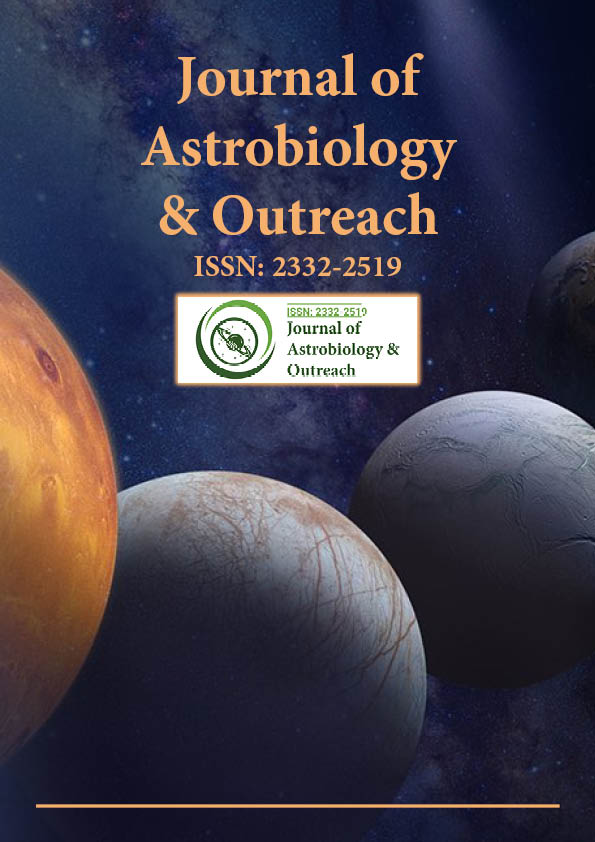Indexed In
- Open J Gate
- Academic Keys
- JournalTOCs
- RefSeek
- Hamdard University
- EBSCO A-Z
- OCLC- WorldCat
- Google Scholar
Useful Links
Share This Page
Journal Flyer

Open Access Journals
- Agri and Aquaculture
- Biochemistry
- Bioinformatics & Systems Biology
- Business & Management
- Chemistry
- Clinical Sciences
- Engineering
- Food & Nutrition
- General Science
- Genetics & Molecular Biology
- Immunology & Microbiology
- Medical Sciences
- Neuroscience & Psychology
- Nursing & Health Care
- Pharmaceutical Sciences
Opinion Article - (2024) Volume 12, Issue 3
Surviving the Extremes: The Role of Extremophiles in Science and Industry
Liam O’Connor*Received: 30-Aug-2024, Manuscript No. JAO-24-27913; Editor assigned: 02-Sep-2024, Pre QC No. JAO-24-27913 (PQ); Reviewed: 16-Sep-2024, QC No. JAO-24-27913; Revised: 23-Sep-2024, Manuscript No. JAO-24-27913 (R); Published: 30-Sep-2024, DOI: 10.35248/2332-2519.24.12.354
Description
Extremophiles, microorganisms that survive and adapt to extreme environmental conditions, have captured the scientific community for their remarkable adaptability and biochemical ingenuity. These organisms, capable of surviving in high salinity, extreme temperatures, high radiation, or acidic environments, offer unique opportunities for industrial biotechnology. Beyond their industrial applications, extremophiles carry significant implications for astrobiology and outreach, serving as a link between fundamental science and public engagement with the search for life in extreme and extraterrestrial environments.
The potential of extremophile cell factories lies in their strong biochemical machinery, evolved to function under conditions that typically denature conventional biological systems. This resilience makes extremophiles valuable for industrial processes that require stability under extreme pH, temperature, or pressure. For example, thermophilic enzymes derived from extremophiles enable efficient chemical reactions in high-temperature industrial reactions, reducing energy requirements and improving sustainability. Similarly, halophilic microorganisms produce biomolecules that remain stable in high-salt environments, useful for bioprocesses in saline conditions.
In the search of astrobiology, extremophiles provide essential insights into the potential for life beyond Earth. Their ability to survive and adapt in extreme conditions analogous to extraterrestrial environments, such as the acidic hydrothermal vents or ice-covered oceans of Earth, informs the search for habitable environments on other planets and moons. For example, Mars, with its cold, arid environment and occasional briny water, resembles the habitats of halophiles and psychrophiles. Studying these extremophiles on Earth helps astrobiologists identify biosignatures—chemical or physical markers of life—that could guide exploration missions on Mars and beyond.
Similarly, the icy moons of Jupiter and Saturn, such as Europa and Enceladus, harbor subsurface oceans under their frozen crusts, environments that could support extremophilic organisms. The study of microorganisms living and adapting in subglacial lakes or deep-sea hydrothermal systems on Earth provides critical analogs for understanding how life might exist and adapt in such extraterrestrial settings. Extremophile cell factories also have the potential to simulate bioprocesses that might occur in these environments, providing experimental frameworks for astrobiological studies.
The application of extremophile-derived enzymes and biomolecules extends to the creation of tools for space exploration and habitation. For example, enzymes capable of operating in extreme conditions could be deployed in lifesupport systems for long-duration space missions, enabling efficient recycling of waste and resources. Extremophile-derived biomaterials, such as radiation-resistant proteins, may find applications in protecting astronauts and equipment from the harsh radiation environments of deep space.
From an outreach perspective, extremophiles serve as a compelling narrative for engaging the public with science. The idea that organisms can survive in boiling springs, acidic lakes, or frozen tundras sparks curiosity and challenges conventional perceptions of life. Tying this narrative to the search for extraterrestrial life captures the imagination of audiences, making astrobiology accessible and exciting. Public engagement programs, documentaries and interactive exhibits often use extremophiles as a path to discuss broader scientific concepts, such as evolution, planetary science and the limits of life.
The study of extremophiles also resonates with efforts to inspire the next generation of scientists. By showing the creativity of life in extreme environments, educators can stimulate interest in STEM fields, particularly among students interested in space exploration or environmental sciences. Outreach efforts that connect extremophile research to practical applications, such as sustainable industrial processes or the development of new materials, also demonstrate the tangible benefits of fundamental science.
In conclusion, extremophile cell factories represent a remarkable intersection of industrial biotechnology, astrobiology and public outreach. Their ability to survive in extreme conditions not only enables innovative industrial processes but also provides a model for understanding life’s potential beyond Earth. By studying and applying extremophile biology, scientists are advancing sustainable technologies, exploring the cosmos for signs of life and inspiring public interest in the wonders of science. As research progresses, extremophiles will continue to play a significant role in addressing both earthly and extraterrestrial challenges, reinforcing their importance as a foundation of modern biotechnology and astrobiology.
Citation: O’Connor L (2024). Surviving the Extremes: The Role of Extremophiles in Science and Industry. J Astrobiol Outreach. 12:354.
Copyright: © 2024 O’Connor L. This is an open-access article distributed under the terms of the Creative Commons Attribution License, which permits unrestricted use, distribution, and reproduction in any medium, provided the original author and source are credited.

